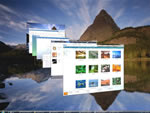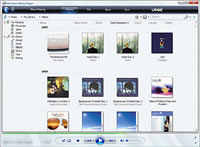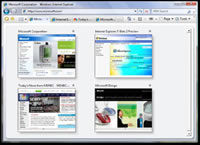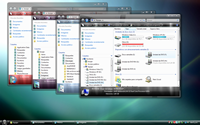
 Windows Vista comes more than five years after the release of Windows XP making this the longest time span between releases of Windows.
Windows Vista comes more than five years after the release of Windows XP making this the longest time span between releases of Windows.
Vista is one of the most substantial updates in the history of Windows in terms of new features and under-the-hood changes and is thought to be the largest and most costly software development project in the history of computing.
Windows Vista has many new and exciting features, such as an updated Graphical User Interface (GUI) dubbed Aero, improved searching technology, a number of new security features, and completely redesigned networking, audio, print and display sub-systems. Vista also aims to increase the level of communication between machines on a home network using peer-to-peer technology, making it easy to share files, password settings, and digital media between computers and devices.
Microsoft's primary stated goal with Vista, however, has been to improve the state of security in the Windows operating system. Amongst the many common criticisms of Windows XP, the most significant has been its security vulnerabilities, and an overall susceptibility to malware, viruses and buffer overflows. In light of this, Microsoft chairman Bill Gates announced in early 2002 a company-wide Trustworthy Computing initiative which aims to incorporate security work into every aspect of software development at the company. This had the effect of significantly delaying the development of Vista, as Microsoft prioritised improving the security of Windows XP and Windows Server 2003 above finishing the next version of the operating system.
Aero: A re-designed user interface, named Aero – an acronym for Authentic, Energetic, Reflective, and Open. The new interface is intended to be cleaner and more aesthetically pleasing than previous Windows, including new transparencies, animations and eye candy.
 Windows Shell: The new Windows shell is significantly different from Windows XP, offering a new range of organization and search capabilities. The Start menu has changed as well; it no longer uses ever-expanding boxes when navigating through Programs. Even the word "Start" itself has been removed in favour of a blue Windows "Pearl".
Windows Shell: The new Windows shell is significantly different from Windows XP, offering a new range of organization and search capabilities. The Start menu has changed as well; it no longer uses ever-expanding boxes when navigating through Programs. Even the word "Start" itself has been removed in favour of a blue Windows "Pearl".
Search: Significantly faster and more thorough search capabilities, similar to what is offered by Microsoft's Windows Desktop Search, Copernic, and Apple Computer's Spotlight. Search boxes have been added to the Start menu, Windows Explorer, and several of the applications included with Vista.
Windows Sidebar: A new panel on the right-hand side of the screen where a user can place Desktop Gadgets, which are small applets designed for a specialized purpose (such as displaying the weather or sports scores). The gadgets can also be placed on other parts of the desktop, if desired.
Windows Media Player 11: A major revamp of Microsoft's popular program for playing and organizing music and videos. New features in this version include word-wheeling  (or "search as you type"), a completely new and highly graphical interface for the media library, and the ability to share music libraries over a network with other Vista machines, the Xbox 360, and other Media Center Extenders.
(or "search as you type"), a completely new and highly graphical interface for the media library, and the ability to share music libraries over a network with other Vista machines, the Xbox 360, and other Media Center Extenders.
User Account Control: A new security technology that allows Windows to operate effectively as a "standard" user with the least privileges, which was often a difficult thing to do in previous versions of Windows because the previous "limited" user accounts proved too restrictive. When an action requiring administrative rights is requested, the user will first be prompted to confirm their action (or be asked for an administrator password if they are not themselves an administrator).
Windows Defender: Microsoft's Anti-spyware product has been incorporated into Windows, offering protection against spyware and other threats. Changes to various system configuration settings (such as new auto-starting applications) are blocked unless the user gives consent. New version uses Windows Automatic Updates to receive definition updates, and also works properly with standard user accounts.
Windows Mail: A replacement for Outlook Express that includes a completely replaced mail store that improves stability, and enables real-time search. A number of features from Outlook 2003 are also included, most notably spam filtering.
Windows Update: Software and security updates have been simplified, now operating solely via a control panel instead of as a web application. Mail's spam filter and Defender's definitions will also be automatically updated via Windows Update.
Internet Explorer 7: Upgraded with support for tabbed browsing, RSS, a search box, a phishing filter, IDN with anti-spoofing technology and improved standards support. ActiveX controls are disabled by default. Also, Internet Explorer will operate in a "protected mode" sandbox which operates with lower permissions than the user, preventing it from accessing or modifying anything besides the Temporary  Internet Files directory. IE7 is no longer integrated with the explorer shell for a better security (Local files typed in IE7 are opened using the explorer shell and website's typed in explorer shell are opened using IE7).
Internet Files directory. IE7 is no longer integrated with the explorer shell for a better security (Local files typed in IE7 are opened using the explorer shell and website's typed in explorer shell are opened using IE7).
Parental Controls: Vista includes a range of parental controls to limit when accounts may be used, what programs and website's are blocked, and monitoring capabilities.
Windows SideShow: Enables the auxiliary displays on newer laptops or on supported Windows Mobile devices. It is meant to be used to display Device gadgets while the computer is on or off.
Speech Recognition: Is fully integrated into Vista, which can be "trained" to understand a user's voice, to activate commands in any Windows application, and to enable voice dictation.
New Fonts: There are many new fonts, including several designed especially for screen reading, and a new high-quality Japanese font. ClearType has also been enhanced.
Every game included with Windows Vista has been rewritten to take advantage of Vista's new graphics capabilities. New games include Chess, Mahjong Titans, Purble Place, and Hold 'Em. The Games section will also hold links and information to all games on the user's computer. One piece of information that will be shown is the game's ESRB rating (The ESRB rating system helps parents and other consumers choose the games that are right for their families. ESRB ratings have two parts: rating symbols that suggest what age group the game is best for, and content descriptors that indicate elements in a game that may have triggered a particular rating and/or may be of interest or concern).
Windows Calendar: A new calendar and task application.
Windows Photo Gallery: A photo and movie library management application. Windows Photo Gallery can import from digital cameras, tag and rate individual items, adjust colours and exposure, create and display slide-shows (with pan and fade effects), and burn slide-shows to DVD.
Windows DVD Maker: A companion program to Windows Movie Maker, which provides the ability to create video DVD's based on a user's content.
Windows Collaboration: This is the replacement for NetMeeting. Users can share applications (or their entire desktop) with other users on the local network, or over the Internet using peer-to-peer technology.
SuperFetch: This will speed up the loading of programs and windows by storing files and programs in memory. Optionally, Superfetch can also use USB 2.0 flash memory drives to cache data for faster access. Though flash memory drives are not as fast as RAM, they have faster access times, and a higher read speed, than magnetic hard disk drives.
Touch-screen support: The inclusion of Touch-screen support will also be a useful additional service.
There’s no denying it: Vista is a RAM-hungry operating system. Whereas XP usually runs great on 512MB, you really need a minimum of 1GB to run Vista acceptably. Using the Aero Glass Theme of Windows Vista you will find 2GB is even better. And if you turn on all these graphical features and keep a lot of memory hungry programs open, then 4GB isn’t overkill.
 If you have enough RAM, the most likely hardware culprit on a slow-moving Vista machine is the video card. You need a fairly high-end card to run Aero at all, but some vendors are selling computers with graphics cards that run it badly. You can find out whether your video card is the bottleneck by checking your Windows Experience Index (WEI) score from the Performance Information and Tools applet in Control Panel.
If you have enough RAM, the most likely hardware culprit on a slow-moving Vista machine is the video card. You need a fairly high-end card to run Aero at all, but some vendors are selling computers with graphics cards that run it badly. You can find out whether your video card is the bottleneck by checking your Windows Experience Index (WEI) score from the Performance Information and Tools applet in Control Panel.
The onboard video adapters in most systems aren’t powerful enough to run Vista properly. If you want to run Aero and be happy doing it, get a card that’s Vista Premium Certified. As with system RAM, the more video RAM you have the better, and if you want to play Vista games, be sure your card supports DirectX 10.
The Aero Glass Theme
This is built on the new Desktop Compositing Engine, adding support for 3D graphics, translucency, animation and other visual effects. This graphic experience is intended mainly for high-end graphics cards.
During Vista's early alpha testing stages, the ATI Radeon 9800 Pro and the nVidia GeForce FX 5900 were the only cards compatible with Aero Glass. Since then, support has been extended to most Direct 9 Graphics cards. At this point, the nVidia FX family and up, and ATI Radeon 9500 and up are supported.
As with system RAM, the more video RAM you have the better, and if you want to play Vista games, be sure your card supports Direct X 10.
Aero Glass will not be available in the Starter and Home Basic editions of Vista.
Aero Basic
This interface will be provided in the Home Basic edition of Windows Vista, and can be used instead of Aero Glass on any other edition. While it will still use the Desktop Compositing Engine, Aero Basic will not have the transparencies, animations, and other advanced graphical effects of Aero Glass. In addition, it will not support Flip 3D, which is Windows Vista's new 3D program switcher. Aero Basic bears some similarity to Windows XP's "Luna silver" theme.
Read more articles about PC repairs, Web design & SEO